As a general rule, Scott says, the more a wastewater system looks like nature, the more successful it is likely to be. Hence, a retention pond, which uses the natural process of soil infiltration to purify standing water, is a better choice than a simple culvert running into a nearby stream. But Scott cautions against simple solutions to a complex problem. “A retention pond is better than nothing at all, but it’s still only a Band-Aid,” he says. “Better than that is a plan that doesn’t look at one site, but looks at the community as a whole and deploys a variety of strategies — from semipermeable pavement, to grassy swales, to nonpaved areas and natural species — all those things working together.”
Even if stormwater retention projects do a good job of keeping pollutants out of our watersheds, the soil that filters runoff doesn’t fare quite so well. “Soil has a high affinity to hold onto pollutants; that’s the point,” says Christianson. “But at some point, you have to remove that soil, and if it’s really hot — if it’s really full of pollution — that’s an issue. You’ve created a brownfield that needs remediation.”
“If we’re able to use, say, 50,000 gallons of irrigation water, then that’s 50,000 gallons we don’t have to treat at the water treatment plant.”
That level of contamination could take up to 100 years, says Ballestero, but cultural practices, like littering or seal-coating driveways, increase the toxicity of soils in retention projects. “If people are doing these things all over the watershed, that stuff will collect in the water. If you don’t put it in there in the first place, it’s much cheaper than the cure. But we’re reluctant to change our cultural practices.”
Variety of Benefits
In Chattanooga, the rainwater filtration and storage system at Main Terrain is one small piece of the complicated puzzle that makes up the city’s stormwater system — but it provides a variety of benefits. For one thing, the irrigation system takes water out of the sewer system altogether, says Chris Davis of Volkert, Inc., who served as the civil engineer on the project. “If we’re able to use, say, 50,000 gallons of irrigation water, then that’s 50,000 gallons we don’t have to treat at the water treatment plant.”
The system also allows a more controlled flow of rainwater into the sewer system. The underground cistern that collects the filtered rainwater from Main Terrain’s retention pond is controlled by a valve that keeps a computerized eye on the forecast. When rain is coming, it lets some of the 40,000 gallons of water in the cistern flow out into the main sewer system, spreading the impact of any storm over a period of days.
A more nuanced impact of projects like Main Terrain, according to Ballestero, is simply bringing attention to the issue of stormwater. “It helps raise public awareness,” he says. “At a demonstration project, the public can see it and kick the tires. They start to understand how they’re improving the water quality, and that’s vital.”
In fact, that kind of cultural awareness may be the most important impact of all. By rendering visible the normally unseen world of stormwater management, projects like Main Terrain might begin to nudge us in the direction of more careful attention to our water resources — before they run down the drain. ![]()
Ensia shares solutions-focused stories free of charge through our online magazine and partner media. That means audiences around the world have ready access to stories that can — and do — help them shape a better future. If you value our work, please show your support today.
Yes, I'll support Ensia!
